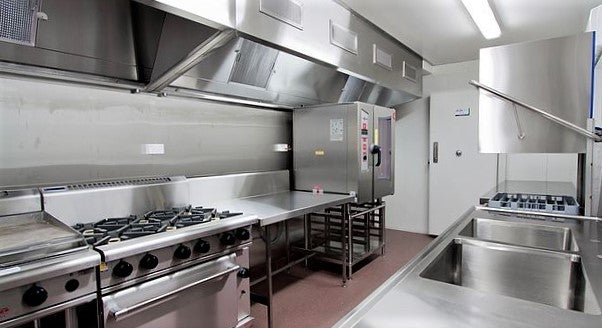Everything You Need to Know About Ghost Kitchens
If you’re wondering what a “ghost kitchen” might be, it isn’t the inside of a haunted restaurant. No, ghost kitchens are designated spaces rented to business owners, with all the equipment and utilities needed to satisfy their hungry customers – only without the seating. Ghost kitchens have been steadily gaining in popularity throughout the pandemic, and they’re something of a godsend for first-time restauranteurs.
This is thanks to low rental fees and the ability to bypass high commission demanded by third-party delivery services, which can exceed a third of your revenue. Not great, given that average restaurant profit margins don’t often go above 6%. The toll taken on the hospitality sector in the past 12 months has been nothing short of devastating, with over 100,000 restaurants forced to close in the U.S.
As a last-ditch attempt to save themselves, many restaurants have tried to keep the lights on by functioning as delivery-only entities. What forced them to close their doors in the end was the combination of high rent – especially in central metropolitan areas, which no longer enjoy the benefit of their urban customer base – and the drastic fees from external delivery services. But the capacity for ghost kitchens to give control back to restauranteurs is such that it may even undercut the food delivery business.
As the ghost kitchen business model expands, it also evolves. In understanding that business model, you’ll need to know about the three different kinds of ghost kitchen, so let’s break them down.
Incubator kitchens

Also known as pop-up kitchens, incubator kitchens are accessories to FSRs (full-service restaurants) optimized for online deliveries. This means one restauranteur could manage two separate streams of revenue, with the main restaurant producing a full range of products while the incubator kitchen may focus on more niche cuisine that requires fewer utilities.
These pop-up kitchens allow additional workspace to process online orders as a secondary source of income, working in conjunction with the principal money-maker – the restaurant they’re attached to – without intruding on any of its food production.
Commissary kitchens
These shared kitchen spaces are the result of savvy property-owners leasing out their available cooking facilities to restaurateurs looking to get their business started. The major benefit of this scheme is that there are reduced up-front costs to contend with, such as lower rental rates, because the space is only being rented for a limited period. This is ideal for startup restaurants who haven’t yet established themselves, in need of kitchen facilities for that initial outflow of product which can be used to evaluate the success of their restaurant going forward.
The simplicity – and appeal – of commissary kitchens derives from their “turn-key” policy, whereby restauranteurs commence business operations the moment they turn the key and step inside. Everything they need – sinks, ovens, fridges and stoves – will be ready and waiting, all included in the temporary lease they signed. On top of that, these shared kitchen spaces are usually leased by large organizations obliged to uphold foodservice regulations and appropriate building codes, so your young business will be in safe hands.
Kitchen pods

Perhaps the most rustic variant of the ghost kitchen, these “pods” are simply shipping containers which have been converted into cooking facilities. Consider this your last resort in opening a food business, as kitchen pods are not well regarded for their safety or practicality.
Often without windows, and almost always cramped to the point of claustrophobic, kitchen pods offer little capacity for interaction between chefs and front of house, thereby inviting a potential breakdown in communication. Kitchen pods may be better suited to one-off events or mini-festivals, but are unlikely to cut it as the heart of a fully-fledged restaurant.
Ghost kitchens lower business overhead
The reality of opening a restaurant is that you won’t see any profit in the first year of operation. The cost of rent, furnishings, labor, ingredients, and marketing, are so extensive that most businesses are fortunate to just break even. Running a restaurant does not a millionaire make.
This is why ghost kitchens have become increasingly popular in recent years, as they sidestep the more stomach-tightening fees involved in running a traditional bricks-and-mortar restaurant. Renting in Manhattan, for example, will set you back $120-per-squarefoot (yikes) while the average rent of a ghost kitchen sits in the vicinity of just $3,000 per month.
Factor in the total lack of furniture, lighting, paint, or wallpaper, and ghost kitchens are able to avoid the typical $160-per-squarefoot fees involved with decorating a restaurant. There’s no need for mood lighting or crystal chandeliers in a ghost kitchen, as no-one but you will ever see it. Instead, the money goes into your ingredients, allowing you to invest in high-quality organic produce.
Ghost kitchens allow you to retain your existing staff
No man is an island, and no business runs itself. A reliable, well-trained workforce is the key component of any successful restaurant and it can take months to establish that kind of working relationship. The beauty of the ghost kitchen is that, when you move your business operations into a rented kitchen, you can take your staff with you.
Removing the need to hire and train new staff, to establish trust that they can perform under pressure and every day of the week, gives you more time to focus on expanding your business. It is much easier to keep the wheels turning when you're able to rely on your workforce to do what’s required – and do it well – and those staff members you put back on the payroll will surely demonstrate their gratitude with hard work.
Opening a restaurant is as exciting as it is daunting, and you’re going to need every ounce of your proverbial blood, sweat, and tears to do it. You’re also going to need some recipe ideas if you haven’t figured out any of your own already, so why not take a look at some of the delicious, nutritious meals we have at Buffalo Market? They may strike a spark of culinary inspiration…


